Your wildlife photography guide.
Explore the grey partridge in detail, study its behavior, prepare your shots.
Where to observe and photograph the grey partridge in the wild
Learn where and when to spot the grey partridge in the wild, how to identify the species based on distinctive features, and what natural environments it inhabits. The WildlifePhotographer app offers tailored photography tips that reflect the grey partridge’s behavior, helping you capture better wildlife images. Explore the full species profile for key information including description, habitat, active periods, and approach techniques.
Grey Partridge
Scientific name: Perdix perdix

IUCN Status: Least Concern
Family: PHASIANIDAE
Group: Birds
Sensitivity to human approach: Shy
Minimum approach distance: 20 m
Courtship display: April to June
Incubation: 23-25 jours
Hatchings: May to July
Habitat:
Open farmland, fallows, scrublands, cultivated fields
Activity period :
Primarily active during the day, with peak activity in the morning and late afternoon.
Identification and description:
The Grey Partridge is a plump galliform bird, measuring 28–32 cm in length with a wingspan of about 45 cm. It is identified by its mottled brown-grey plumage and a distinctive dark horseshoe-shaped patch on the belly. Males and females are very similar, though the belly patch is usually more defined in males. Found in open farmland, grasslands, fallows, and cultivated fields across Europe and temperate Asia. It is ground-dwelling and sedentary, preferring to run rather than fly when disturbed. Its diet includes seeds, leaves, shoots, and insects, which are vital for chicks. The species is in decline in some areas due to agricultural intensification, habitat loss, and pesticide use.
Recommended lens:
300 mm – adjust based on distance, desired framing (portrait or habitat), and approach conditions.
Photography tips:
Use a telephoto lens and approach slowly, blending into the farmland landscape to observe the grey partridge without startling it. Morning light enhances the texture of its plumage. Be patient to capture natural group scenes or feeding behavior.
The WildlifePhotographer App is coming soon!
Be the first to explore the best nature spots, track rutting seasons, log your observations, and observe more wildlife.
Already 1 439 wildlife lovers subscribed worldwide

